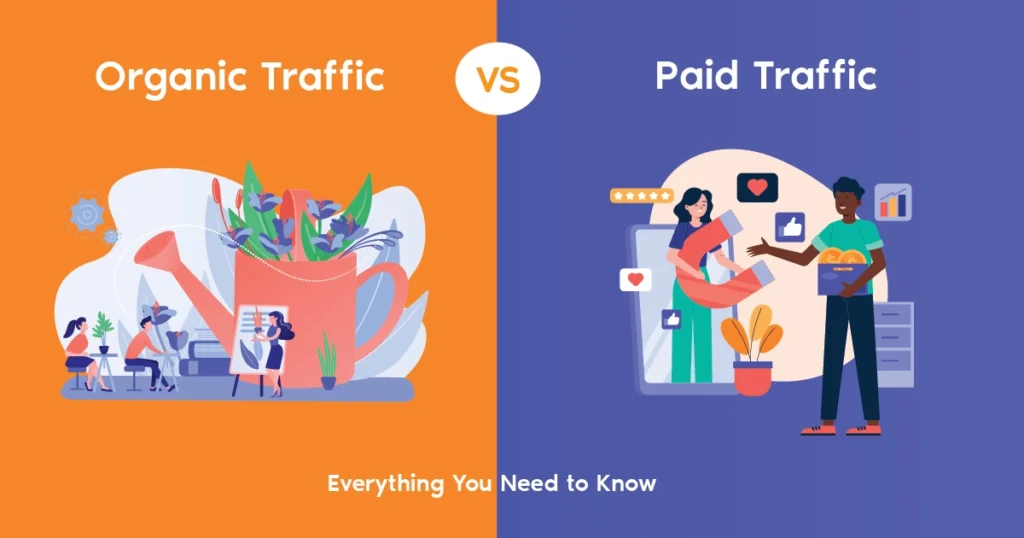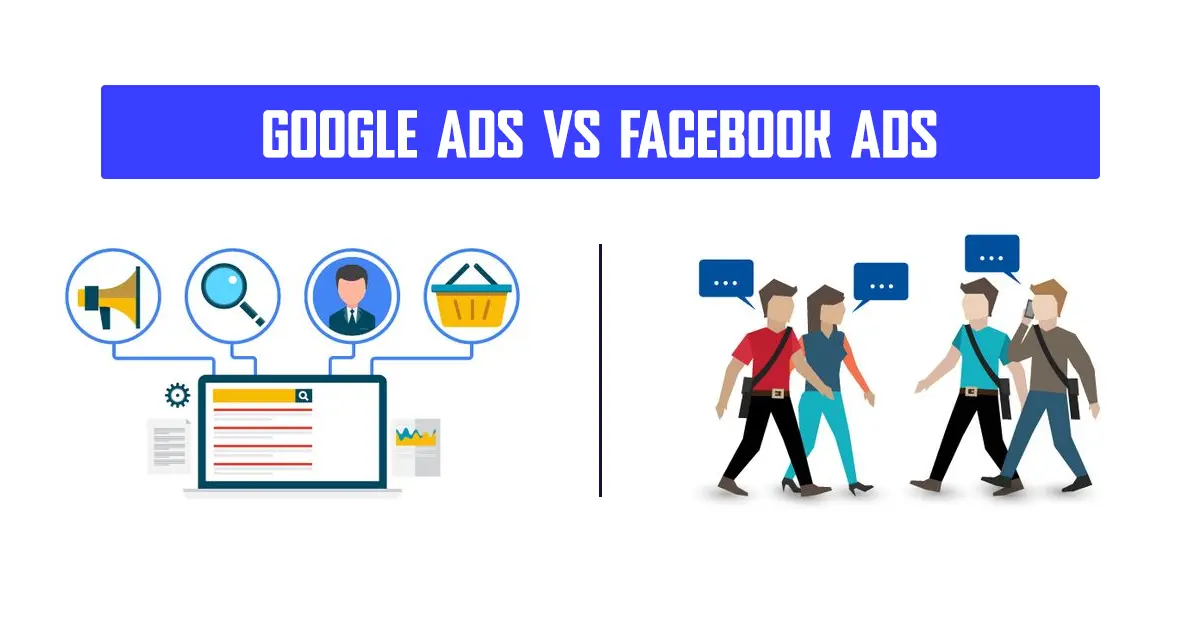In today’s changing online marketing world, it is essential to know how to get traffic to your site. Organic traffic and paid traffic are the two biggest sources that dominate this space. Both desire eyeballs on your products, services, or content, but they operate on their own principles, each having pros and cons. Organic traffic vs Paid Traffic For companies to thrive on the internet, an understanding of these two drivers – and how they coexist – is imperative.
What is Organic Traffic vs Paid Traffic?
Organic traffic is actually people visiting your page organically, not paying you to click. It occurs most frequently when people navigate through search engines like Google, Bing, or Yahoo by clicking non-pay results. It is similar to earned visibility. It is a direct outcome of good Search Engine Optimization (SEO) work, quality content, and a well-built site structure.
Paid traffic, on the other hand, is precisely what it sounds like: visitors who come to your website because you’ve paid for an advertisement that led them there. This includes Pay-Per-Click (PPC) ads on search engine results pages (SERPs), social media advertisements, display ads, and more. With paid traffic, you’re essentially buying immediate visibility and a direct route to your target audience.
Paid vs. Organic Marketing: A Strategic Overview
The paid vs. organic marketing decision is not necessarily an either/or suggestion for most companies. Rather, it’s a question of when to utilize each technique for the desired purpose.
Organic marketing is a game of the long haul. It’s one of becoming authoritative, trusted, and enduringly visible. So, it consists of making valuable content that responds to user queries, technical improvement of your website, and acquiring backlinks from authoritative websites. The payoff is cumulative: if you rank well once, you can get traffic again and again without an overt per-click cost. This strategy elicits authentic engagement and creates a loyal constituency over the long haul.
Paid advertising, of course, offers immediate gratification and precise targeting. Need to launch a new product and get eyeballs immediately? Last-minute promotion? Paid campaigns can deliver traffic overnight. Target your audience by demographics, interests, and web behavior so that your ads hit the best prospects likely to convert. Though it involves ongoing expenditure, the freedom of customizing your reach and quickly testing various messages makes it priceless for speed wins and scaling.
SEO Organic Traffic Driven: The Foundation of Long-Term Growth
When we refer to organic website traffic, we’re usually referring to the force of SEO. SEO-powered organic traffic is the holy grail for most businesses since it’s affordable and sustainable in the long run. Search engine optimization boosts your chances of appearing higher on search results for keywords.
This entails a multi-faceted process:
Keyword Research: Learning what words and phrases your target audience searches on to look for information about your company.
On-Page SEO: Optimizing individual website pages, i.e., content, title tags, meta descriptions, and alt text on images.
Technical SEO: Getting your site crawlable and indexable by search engines, loading fast, and mobile-friendly.
Content Marketing: Creating high-quality, valuable, and relevant content (blog posts, articles, videos) that answers user queries and establishes your authority.
Off-Page SEO: Building a strong backlink profile by obtaining links from other reputable sites, which lets the search engines know that your site is legitimate and has authority.
The beauty of SEO is that if your content is ranking, it will keep attracting traffic without an ongoing per-click cost. Though it requires ongoing effort and time, the reward can be significant, building a strong, credible web presence.
Paid Web Traffic: Instant Gratification and Scalability
Organic is wonderful, but sometimes you must wake your traffic up or hit a very narrow slice of the market. This is when paid web traffic excels. Ad offerings such as Google Ads (for search advertising), Facebook Ads, LinkedIn Ads, and various display ad networks enable you to pay on a per-impression or per-click basis.
The main benefits of paid traffic are:
Instant Visibility: Campaigns can be live in hours, generating traffic in hours.
Targeting Accuracy: You can speak to your audience with ruthless specificity, reaching someone by age, location, interests, job function, and even prior web activity (remarketing).
Scalability: With enough budget, you can expand your volume of traffic quickly.
Measurable Results: Paid platforms offer in-depth analytics, making it possible to monitor performance markers such as click-through rates (CTR), cost-per-click (CPC), conversions, and return on ad spend (ROAS). The data makes it possible to optimize in a matter of minutes.
The biggest pitfall is that the traffic ceases once your budget is depleted. It’s a continuous cost, and bids may inflate due to competition.
Organic Search and Direct Traffic: Unraveling User Intent
Remember that organic search and direct traffic are not the same, although both qualify as “unpaid” traffic. Their origin and intent are different.
Organic search is where the users have actually visited and searched something on a search engine and landed on your page through an unpaid search. Their intent is usually discovery or information seeking.
Direct traffic refers to a situation where the user manually enters your website’s URL in their browser, or uses a bookmark, or clicks on a link from an off-line medium (e.g., business card or brochure). This would usually mean that there is high brand awareness or loyalty because the user already has your website URL in mind. Direct traffic can also sometimes be a residual for traffic where analytics software could not identify the source accurately.
Organic vs. Paid: The Synergistic Solution
In the end, the best digital marketing solution is often a combination of organic vs. paid campaigns.
Paid campaigns can accelerate organic growth: You can use paid ads to test keywords and messaging before investing in long-form content for SEO. Ads can also drive initial brand awareness, leading to more direct searches later.
Organic can enhance paid campaign performance: Having a good organic footprint and a well-respected site can enhance the quality score of your paid campaigns, which means your CPC will be reduced and ad position enhanced.
Explore:
Your Guide to Affordable Digital Marketing in the USA
Why a Digital Creative Agency in Pakistan is Your Brand’s Best Ally
Remarketing: Build users up to your site by means of organic traffic, and remarket them by paid ads to have them come back and convert.
By strategically blending both paid and organic activity, companies are able to establish a strong and sustainable web presence, optimizing their reach, engagement, and conversion.
FAQs
In the organic traffic vs paid traffic debate, organic takes time. It usually takes 3–6 months to start seeing results and up to 12 months for significant growth—especially in competitive niches.
Not always. In organic traffic vs paid traffic, paid gives faster results but costs per click. Organic needs time and effort but is cheaper long-term once rankings are achieved.
Track organic success via keyword rankings, traffic, and conversions (Google Analytics/Search Console). For paid, check CTR, CPC, CPA, and ROAS using ad platforms like Google Ads or Facebook Ads.




